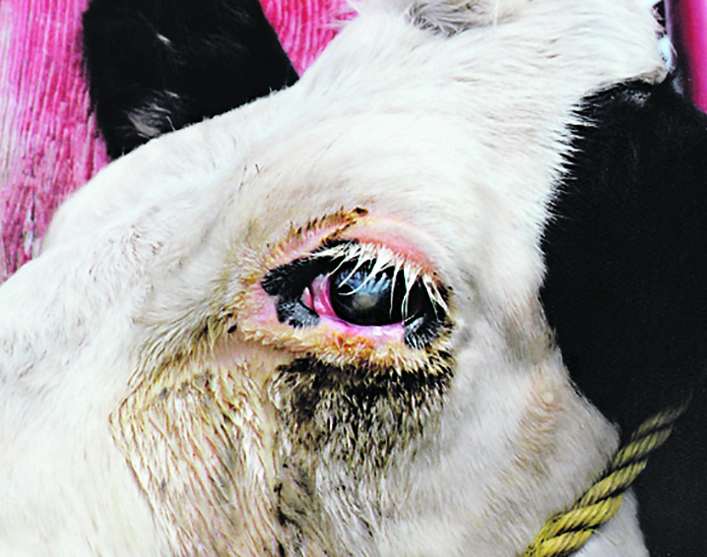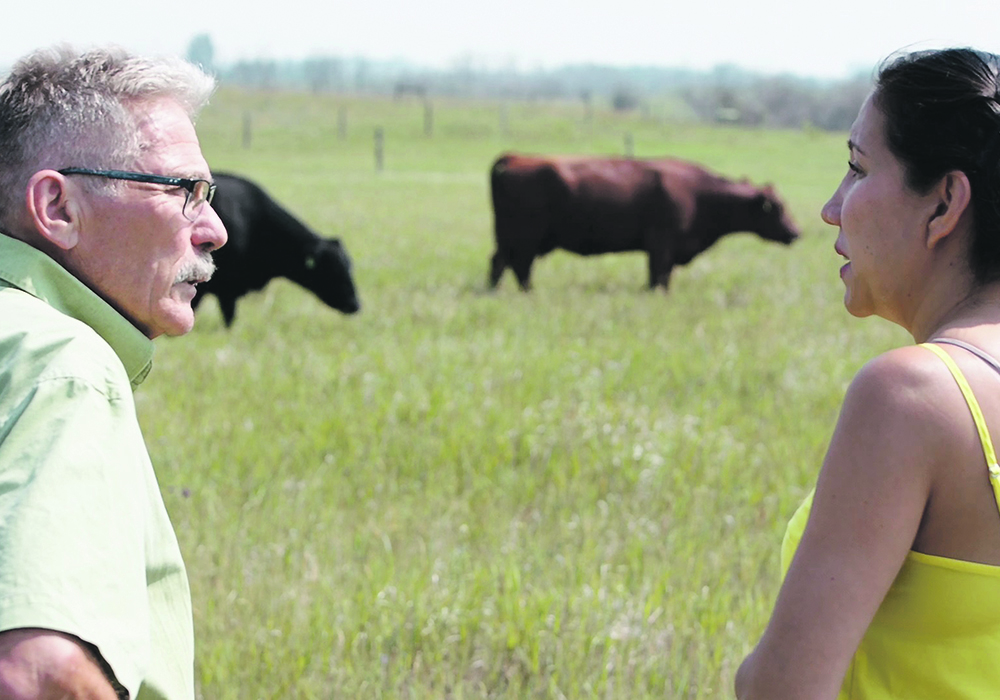A vaccine delivered directly into the animals’ eyes promises cattle producers a new tool to manage pinkeye.
“We are taking this novel approach to vaccine delivery since we and others have shown that the currently available vaccines, which are injected subcutaneously, do not prevent outbreaks of pinkeye in cattle and do not increase local antibody production in the eye,” said Dr. Philip Griebel.
He is a researcher at the Vaccine and Infectious Disease Organization (VIDO) at the University of Saskatchewan, where he holds a Canada Research Chair in Neonatal Mucosal Immunology. For the past four years, he has led a team working to develop a vaccine against pinkeye, or infectious bovine keratoconjunctivitis. Saskatchewan’s Agriculture Development fund and the Beef Cattle Research Council are providing funding for the work.
Pinkeye is a painful infection that causes visible inflammation and damage to the eye. Left untreated, it can attack the cornea and cause blindness. Animals with pinkeye tend to eat less and lose weight. According to veterinary researchers, the disease is second only to scours as the most costly disease in pre-weaned calves.
Dr. Eugene Janzen is one of the research team’s collaborators at the University of Calgary. He acts as the team’s field investigator for pinkeye on pastures in Alberta’s Porcupine Hills, collecting samples of bacteria from cows’ eyes for use in the project.
Janzen said pinkeye is caused by pathogens that usually live in an animal’s respiratory tract as part of the natural microbiome. But they can get brushed into the eyes by tall grass or face flies.
Usually, these organisms do no harm, particularly since the eyes are protected by a “tear film” made of water and mucous that catches foreign particles to be swept away as the animal blinks. But excessive wind, dust, tall grass and even excessive ultraviolet light can compromise this protective layer, letting pathogens through. Once there, they release toxins that damage the cornea and other tissues of the eye.
Unfortunately, when cattle bunch together to seek shade and get out of the sun or to avoid flies, infected individuals can spread the bacteria.
While pinkeye can be associated with several bacteria and exacerbated by at least one virus, the VIDO team is concentrating its efforts on two bacteria: Moraxella bovis and Moraxella bovoculi. Griebel said experiments show the first is the main offender, with M. bovoculi coming along for the ride to help wreak havoc once infection is already underway.

One of the challenges in controlling pinkeye is speed: by the time a producer notices an animal that is squinting with obvious pain or has excessively watering eyes, the problem is likely already entrenched. Worse, bringing animals together for treatment can allow pinkeye to spread, so producers sometimes treat the whole herd as a precaution.
“Producers can spend a lot of time dealing with this disease in an outbreak situation,” Janzen said. “If you just treat them individually, it’s very difficult to keep up.”
The VIDO vaccine would allow producers to treat the afflicted animals while at the same time shielding those who are still healthy. This means the immune response has to be fast and it has to provide protection at the scene of infection: the eye.
“What we’re trying to do is first come up with a vaccine that’s easy to administer, second that it’s capable of inducing an immune response fast enough that it will stop the outbreak,” said Dr. Paola Elizalde. A doctoral student with VIDO and the U of S School of Public Health, she is conducting the research on the new vaccine.
“So, Moraxella is a bacteria that needs to attach to the eye. If we can induce enough antibodies quickly enough, there will be no harm to the eye.”
Elizalde has a shopping list for the vaccine: it must accelerate and maintain immune response in the eye. It has to be effective with one dose, and it has to bring this immune response online within a week or two, before the animals go out to pasture. She is working on the novel delivery route, basically eye drops for young calves, with fellow VIDO researcher Dr. Siresh Tikoo.
At this stage, the researchers are testing the direct-to-eye vaccine method for safety. It will likely require a few more years of study to find out if the vaccine prompts the creation of antibodies, and what age works best for this aspect.
“In newborns, there is a lack of immune response to Moraxella,” Elizalde said. “In two-month-olds, it increases by a little; in yearlings, the immune response is very high.”
Griebel said applying the vaccine directly to the eye would allow producers to protect cattle even in the midst of an outbreak.
“We also think that our vaccine, by delivering it to the eye, by inducing local immunity quickly, could be used in the face of an outbreak,” he said, since all animals could be brought in and vaccinated. It would also allow precision treatment.
“You might not prevent infection in the right eye which already has inflammation and damage, but by vaccinating the other eye, they can protect the healthy eye,” he said.















